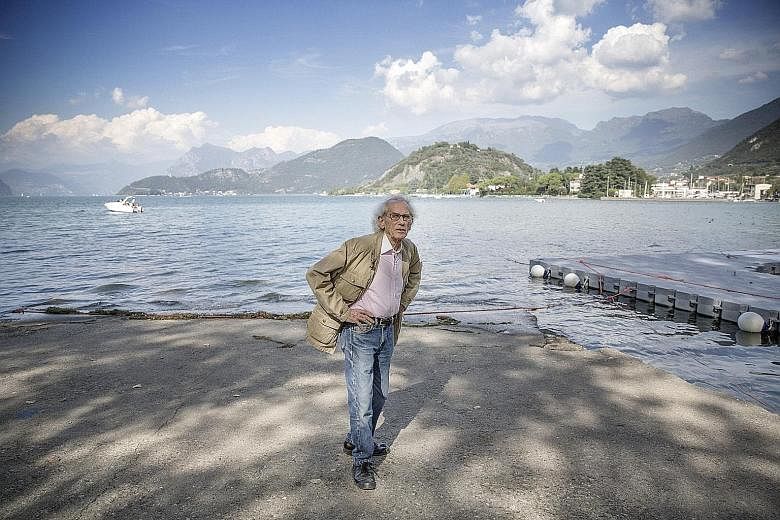NEW YORK • It has been a decade since those 16 days in February 2005 when artist duo Christo and Jeanne-Claude installed 7,500 gates along Central Park's walkways, each adorned with shimmering saffron-coloured panels creating what Christo described as "a golden river appearing and disappearing through the branches of the trees".
It was a spectacle like no other in the park's long history. The US$20- million project, financed by the sale of Christo's artworks, pumped nearly US$250 million into the city's economy and attracted four million visitors.
Whether they were wrapping the Reichstag in 92,903 sq m of fabric or raising a 111m-high curtain across a valley in Colorado, Christo and Jeanne-Claude produced visual feats that resonated with the public in a way few artists have.
But since Jeanne-Claude's death in 2009 from complications of a brain aneurysm, some wondered if the dream had died too.
It seemed to many that Christo, 80, had disappeared from public view. The couple had been inseparable for 47 years and were collaborators for most of that time.

In fact, Christo has been quietly busy. And he is poised for a comeback on his own. His first commercial art exhibition in nearly 50 years opens on Nov 6 at the Craig Starr Gallery in Manhattan, with examples of some of his earliest works, his Show Windows and Store Fronts, architectural installations he started making in the early 1960s, shortly after he and Jeanne-Claude arrived in New York from Paris.
But it is The Floating Piers, his first fantastical outdoor installation since The Gates and the first project conceived since Jeanne-Claude's death, that consumes his every waking hour.
For 16 days from June 18, on Italy's Lake Iseo, the public will be able to walk for nearly 3.2km on water, atop 200,000 floatable cubes covered in glittering, dahlia- yellow fabric fashioned from tightly woven nylon.
"They will feel the movement of the water under foot," Christo said. "It will be very sexy, a bit like walking on a water bed."
He took a car ride last year from Stuttgart, Germany, to his warehouse in Basel, Switzerland, with his nephew Vladimir Yavachev and Wolfgang Volz, his photographer and project manager for The Floating Piers.
"I cannot wait so long anymore," he told them. "I am not sure I will live another 10 years. We should do something not so complicated. Something we can manage. Something we can actually get done."
Lake Iseo is perhaps the least known of Italy's northern lakes, an idyllic spot with two small islands. The Floating Piers, 96km east of Milan, will connect the islands to each other and to the mainland.
"You will be able to walk the entire area," Christo said. The project will be visible from the surrounding mountains. As the light changes throughout the day, the view of the piers will change too, from deep yellow to shimmering gold to a reddish hue when wet.
About 500,000 people are expected to visit Piers as its opening is timed to coincide with the last two days of Art Basel, the contemporary art fair. The project is estimated to cost about US$11 million (S$15.3 million), money that Christo said he has already raised from the sale of his art.
Scientists, structural engineers and divers, with teams of construction workers, have been involved in the Piers creation, floating a section with the covered fabric on a lake in Germany last year to see how they would look. In February, Christo tested the structural integrity of the piers for wind and wave heights by placing sections in the Black Sea. From December, divers will place 140 five-ton anchors up to 91m deep in Lake Iseo. Right now, about 92,903 sq m of fabric is being specially woven in a factory in Germany.
The final installation is to take a week and will involve a team of some 600 workers.
Again, as he and Jeanne-Claude did beginning in the 1980s, Christo plans to give each visitor a party favour of sorts, perhaps an actual piece of fabric from the installation.
"Normally, it's a postcard you bring home," said project director Germano Celant. "A bit of fabric becomes a part of history."
Given the ephemeral nature of these installations, all that remains is the indelible memory. "It creates an incredible urgency because it will never take place again. That's why it's so exciting," said Christo.
NEW YORK TIMES

